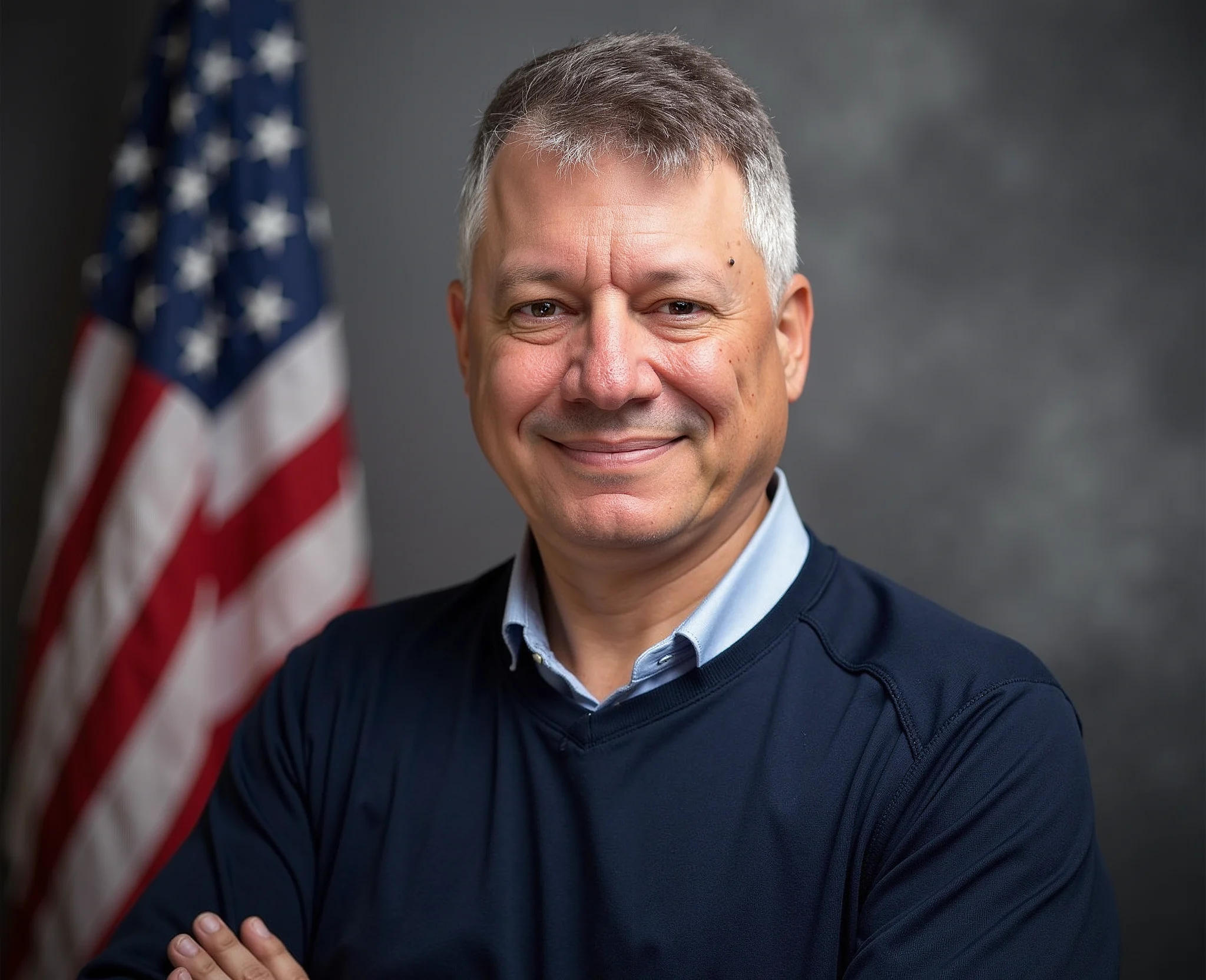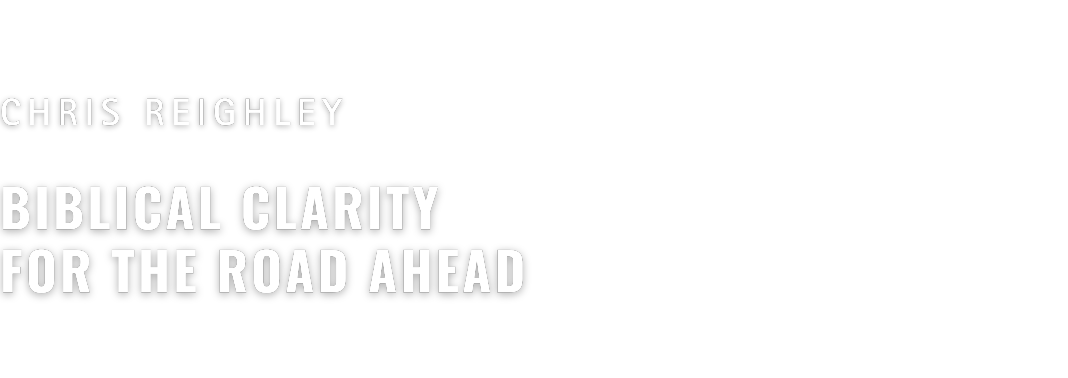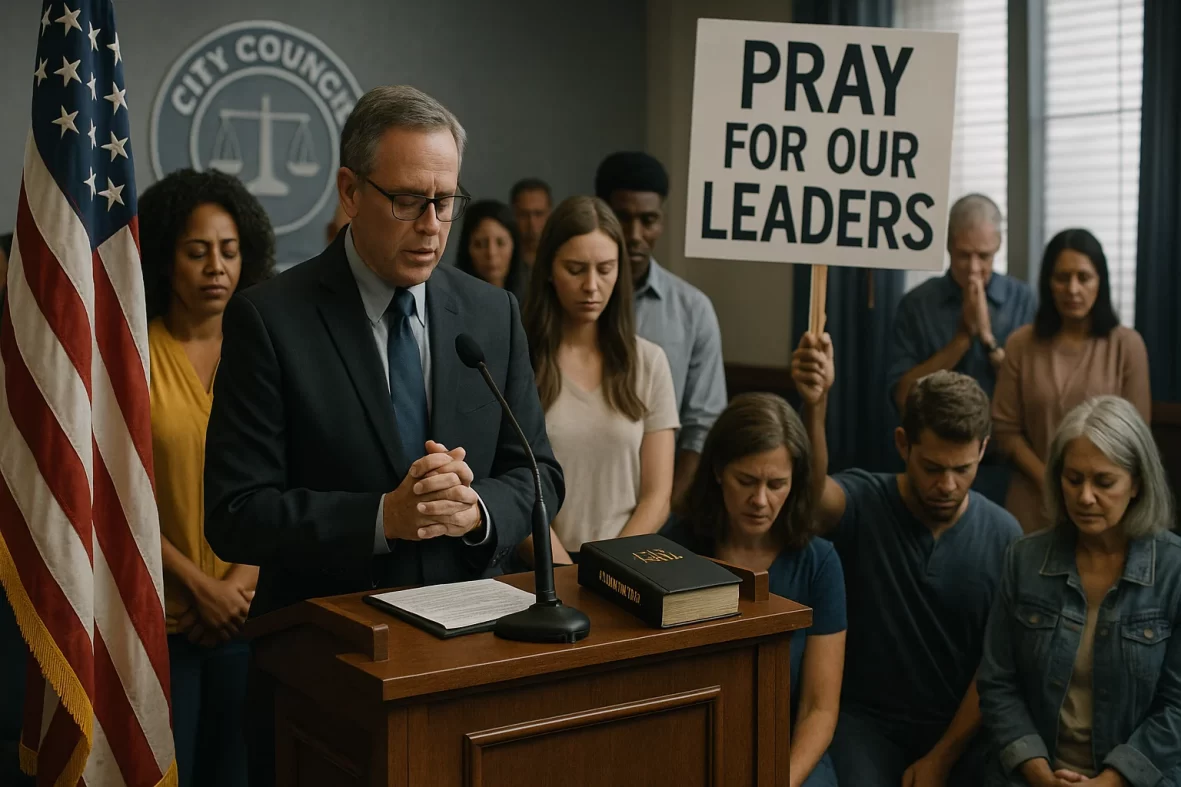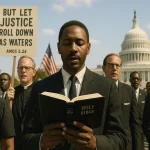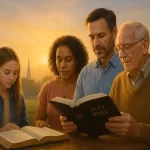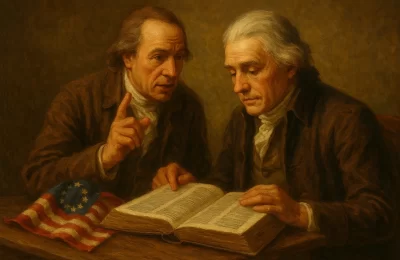Part 11 of Civic Theology: How the Bible Shaped America’s Founding and Freedom
Modern America lives at the intersection of centuries of biblical conviction and 21st-century innovation. An open Bible lies next to a smartphone and coffee mug, a simple scene capturing our age: the eternal Word in one hand, the digital world in the other. Today, Scripture still whispers in the halls of power and sings on our screens, but its voice sounds different than it did a generation ago. In the early 1950s, for example, President Eisenhower quietly reminded Americans of their spiritual heritage by adding “under God” to the Pledge of Allegiance . As Ike explained at the signing, we were affirming “the transcendence of religious faith in America’s heritage and future” as a bulwark against worldly fears . That theme – faith giving moral ballast to freedom – runs through our national story. Yet by the 21st century, the places where Bible and public life meet have shifted. Many official rituals (like school prayer) were struck down by the courts, others (like legislative invocation) were upheld; politicians alternately quoted Scripture and pleaded for civility; and churches expanded their outreach beyond steeples into cyberspace. This chapter surveys those shifts – from “under God” to TikTok – showing how the seeds of Scripture continue to bear fruit in unexpected places.
Faith in the Public Square:
Milestones and Court Battles
In our republic’s early years, Bible readings, prayers, and moral exhortations were common in civic life. But by the mid-20th century, the Supreme Court began curtailing state-sponsored prayer. In Engel v. Vitale (1962), for instance, the Warren Court famously held that a New York regents’ prayer – even voluntary and nondenominational – could not be composed by government officials for public schools . Justice Hugo Black wrote that government-written prayers “violat[e] the Establishment Clause” and exclude some faiths even if well-meaning . That decision set a tone of separation that lasted for decades. Yet the pendulum has swung back in surprising ways. In Town of Greece v. Galloway (2014), the Court upheld opening local meetings with a clergy-led prayer, noting that legislative invocations are a long-standing tradition compatible with the First Amendment . Even sectarian prayers (“the Lord, in your mercy…”) were allowed so long as the town did not coerce dissenters. In effect, the Court said that legislative prayer “fits within our Nation’s heritage” and is constitutional for town councils . In practice this has led many city councils, school boards, and legislatures to welcome invited chaplains of all faiths – or even rotate multiple traditions – at public meetings. Bible readings and prayers are once again common at local government events in many parts of the country, reflecting America’s lingering appetite for invoking God’s guidance (even if courts insist it be voluntary and non-coercive).
At the same time, there have been flashpoints of conflict. School boards have scrapped moment-of-silence prayers; Christmas creches sometimes draw lawsuits (e.g. the Ten Commandments in Alabama); and conservative activists have pressed for conscience protections for individuals with traditional views on marriage, life, or healthcare. Courts continue to grapple with these issues. For example, Kitzmiller v. Dover (2005) dealt with science class curriculum: it struck down a Pennsylvania school board’s attempt to teach “intelligent design,” calling it “stealth creationism” that illegally injected religious doctrine into public schools . Debates over creation versus evolution still flare up, often in textbooks and school board fights. Meanwhile, battles over “free exercise” of religion appear in cases like Hobby Lobby (2014) and Masterpiece Cakeshop (2018), where business owners claimed that laws on contraception or gay marriage violated their religious conscience. These cultural flashpoints show how Americans are still sorting out the role of faith in civic life: we may not legally mandate Bible-reading, but individual conscience and community values keep these questions alive.
Presidents and Public Prayer:
From Reagan to Obama
Recent presidents have been eager to anchor public discourse in faith rhetoric and biblical values. Ronald Reagan, for example, proclaimed 1983 the “Year of the Bible,” calling Scripture “the rock on which our Republic rests” . In his proclamation, Reagan celebrated how generations of leaders – from Washington to Lincoln – had drawn on biblical principles. Quoting Andrew Jackson, he noted the Bible was “the rock on which our Republic rests,” and urged Americans to “reexamine and rediscover” its message . This was no mere ceremony: Reagan frequently said things like “Above all, in the present crisis, government cannot replace the providential mercies of God” and encouraged citizens to hold onto faith and patriotism. Similarly, President George W. Bush often invoked Scripture in his speeches. In his first inaugural address (2001) he referenced the Good Samaritan parable (Luke 10) when he vowed, “When we see that wounded traveler on the road to Jericho, we will not pass to the other side.” . This line – spoken as Bush spoke of compassion and civic duty – framed his “compassionate conservatism.” Bush spoke explicitly about mercy, saying that helping the least fortunate (the Samaritan’s neighbor) was central to America’s mission. He later pointed to Jesus’ parable as the inspiration for his policy of empowering faith-based charities without imposing state religion.
Barack Obama, too, brought faith-talk into public life, though with a different tone. In a 2011 prayer breakfast address, President Obama openly described “my faith” as a source of strength. He admitted that his job “has a funny way of making a person feel the need to pray,” and said he regularly asked God to help him serve “those who are struggling.” Quoting the New Testament, Obama said it was “my faith, then, that [the] biblical injunction to serve the least of these, that keeps me going” . (That phrase, echoing Matthew 25:40, underscores how helping neighbors in need is a Christian duty.) Obama also praised faith-based non-profits and encouraged people of all faiths to translate their values into civic action. Even as Americans have become more religiously diverse, these presidents have shown a willingness to cite Scripture or pray in public – for example, Obama often closed speeches with “God bless you and God bless America,” much as presidents have done for generations. Thus from Reagan’s “rock” to Obama’s “least of these,” presidents have continued a tradition of bringing biblical imagery into the public square, illustrating the enduring influence of religious language in political leadership.
Cultural Currents:
“Nones,” Science, and Conscience
American culture in the 21st century has also shifted in ways that affect faith and politics. On the one hand, the United States is becoming more secular: nearly 30% of Americans now say they are “religiously unaffiliated” or “none” . This is up sharply from just a decade earlier. These “nones” include atheists, agnostics, and those who answer “nothing in particular” when asked about religion. Pew Research finds this group questioning traditional beliefs but not necessarily anti-religious – many still believe in God or a higher power, and they are a growing share of younger generations . Politically, this means that appeals to “Judeo-Christian values” no longer automatically command unanimous assent. Lawmakers now navigate a more pluralistic landscape. We see this in debates over science education or medical ethics: school boards in some districts still teach creationism or “intelligent design” as science (sparking court fights like Kitzmiller v. Dover ), while others have rejected such curricula. In Congress and statehouses, bills have been introduced to protect the conscience of doctors and pharmacists who object to procedures like abortion or contraception – a reflection of how faith-based convictions on social issues have become political flashpoints. These conscience-protection efforts (and the legal cases that test them) show how deeply held religious beliefs are seeking accommodation in a pluralistic society.
At the same time, cultural debates have highlighted shifts in public morality. Evolution vs. creationism is one battleground; another is sexual ethics and family structure. Americans are wrestling with how religious liberty intersects with LGBT rights, women’s rights, and immigration. Christian leaders and laypeople have taken stands on both sides. Some civic forums still open with prayer or Bible readings; others remain strictly secular, invoking a “wall of separation.” But even in fervently secular environments, religious language pops up. For instance, a surprising number of popular songs, films, and memes have biblical references – sometimes reverently, sometimes irreverently. (It’s a sign of the Bible’s ubiquity that Beyoncé’s song lyrics or a Twitter meme might unknowingly echo Scripture!) In recent years, movies about faith have become box-office hits, and pop stars occasionally weave spiritual imagery into their performances. These moments – a priest posted on TikTok, a football player kneeling in prayer – remind us that faith gestures are still part of the cultural conversation, even if the context has changed.
Faith in Action:
Compassion and Civic Service
Despite these tensions, many Christians have channeled their beliefs into public service and advocacy. The faith-based initiatives of the early 2000s, for example, embodied President Bush’s vision of “compassionate conservatism”: partnering with churches and charities to fight poverty, AIDS, and illiteracy. The Good Samaritan motto Lord, let me be your hands became a popular way to express this ethos. Such efforts continue beyond Washington. Today, pastors, congregations, and network ministries are deeply involved in issues like immigration reform, human trafficking, and religious liberty. In border towns and big cities alike, churches have run refugee resettlement programs and job training; Christian coalitions lobby Congress to welcome immigrants and ease their path to citizenship. Anti-trafficking groups (many faith-based) work with law enforcement to free slaves and care for survivors. Clergy testify before city councils on crime prevention, and youth pastors mentor gang members. These are concrete expressions of Scripture’s social mandate: showing mercy, defending the oppressed, and loving neighbor (cf. Micah 6:8).
Even in politics, lay Christians have formed new bridges. Some evangelical CEOs have founded charities; believers in academia host community forums on faith and democracy; interfaith prayer breakfasts build personal relationships across the aisle. The result is that, in many cities, the public square still resonates with Christian commitment – not as an establishment of church, but as a chorus of citizen voices. A city council in Texas might start with a moment of silence followed by a Bible reading; a university senate might welcome faith-based speakers. Courtrooms, hospitals, and prisons often begin with optional prayers or devotional readings. All these reflect an enduring belief (as Proverbs says) that “when the righteous are in authority, the people rejoice” . And when leaders neglect virtue, society truly does groan under the burden of corruption.
The Digital Pulpit:
Podcasts, TikTok, and New Media
Not everyone wears a robe to speak truth. In the digital era, the pulpit can be as small as a smartphone or as broad as a live-streamed campus sermon. We see a new public theology emerging online. Podcasts by prominent pastors (from John MacArthur to Tim Keller to Francis Chan) have millions of downloads, preaching the Gospel in people’s cars and headphones. YouTube channels for churches (mega-churches like Elevation, Hillsong, and small home churches alike) broadcast sermons to global audiences. Even TikTok and Instagram are awash with faith testimonials and Bible verse reels. One trending #Bibleverse on TikTok garnered tens of millions of views in a week, as Gen Z users wrestle with identity and meaning in bite-sized clips. Animations retell parables, influencers challenge viral skeptics with theology, and ordinary believers post videos of their conversions.
This digital shift is both continuity and change. It continues the great tradition of “walking with God” and spreading His message, just now through new channels. It changes the shape of community: people no longer need to live near a seminary to hear a sophisticated sermon, nor travel to Israel to join a virtual Bible study on the Mount of Olives. The same ancient Scriptures (Romans, Psalms, Proverbs, etc.) still captivate, but now in formats that earlier reformers could not imagine. To the millennial who skips church to binge Christian podcasts, 1 Timothy’s command “to pray for kings and all who are in high positions” (1 Tim 2:1–2) is delivered by a headphones-wearing citizen praying through the Capitol. A college student reading Micah 6:8 on a digital Bible app may feel called to civil justice. And all over social media, verses like Colossians 3:23–24 (“Whatever you do, work heartily… knowing that from the Lord you will receive the inheritance”) circulate as graphics, reminding young professionals to see their work as worship.
Contemporary examples abound. School-prayer controversies still surface (for example, after the 2022 Kennedy v. Bremerton decision, a high school coach won the right to pray on the football field), but social media often frames these stories in biblical terms. City councils have resumed invocations and even Bible-reading ceremonies (sometimes attracting news headlines). Churches print sermons that go viral (remember the pastor whose sermon clip became a TikTok meme about making one’s bed?). On the lighter side, pop culture even riffs on the interplay of faith and media: one internet joke quipped, “If Moses had Instagram, would the Ten Commandments be #10Trending?” The point is that Americans keep hashing out faith and freedom in public – now via tweets and Facebook posts as well as speeches and protest marches.
Biblical Vision for Our Civic Life
Underlying all these changes is a constant truth: the Bible still offers a framework for thinking about government, law, and community. Scripture urges us toward justice, mercy, and humility (Micah 6:8), and reminds leaders that they serve a higher King. It charges citizens to love one another (Romans 13:8–10) – meaning that “loving your neighbor” is actually the sum of the law. In our divided times, that mandate rings clearly: political engagement isn’t just power-brokering, it’s neighbor-loving when done rightly. We are instructed to “do justice, love kindness, and walk humbly with God” (Micah 6:8) in every era. We are told to pray for our rulers (1 Timothy 2:1–2) and to work in all things “as for the Lord, not for men” (Colossians 3:23–24) – whether online or onsite, in government or in business.
The Psalmist reminds us that God’s words are “pure words, like silver refined in a furnace” (Psalm 12:6) – a poetic assurance that even amid noise, Truth endures unchanged. And Proverbs warns that society thrives when righteous people lead: “When the righteous increase, the people rejoice; but when the wicked rule, the people groan” (Prov. 29:2). These timeless principles help Christians interpret modern politics: we rejoice where God-fearing citizens make decisions, and we lament injustice elsewhere.
Ultimately, the drift toward “nones” and the rise of digital religion do not negate the civic role of Scripture; they transform it. Whether through a prayer breakfast or a podcast, the message of the Gospel finds new public stages. A Facebook post of Romans 13 goes viral, or a preacher on YouTube cites Colossians in a live debate over public policy. In these ways, the seeds of Scripture still bear unexpected fruit – shaping conscience, culture, and community well beyond church walls. We see that even as America’s culture shifts from pews to pixels, the core truths of Scripture continue to guide citizens who know that faith and freedom belong together.
In the end, American civic life remains a tapestry woven with Christian threads. It is conversational and contentious, hopeful and humble – just as the Bible teaches us to be. As believers in Christ, we can engage the public square knowing that our anchor holds fast. Though forms change – from spoken prayer to smartphone sermon – the substance of God’s Word endures. Like the ancient promise that Abraham’s God is the same “God who hears” (Genesis 21:17), so today we trust that every act of public faith – whether a tweet or a town-hall prayer – can honor the Lord and serve our nation. May we continue to sow seeds of Scripture boldly, believing they will flourish even in this new season of freedom and challenge.
References:
Dwight D. Eisenhower. (1954, June 14). Statement by the President upon signing bill to include the words “Under God” in the Pledge to the Flag. The American Presidency Project.
Little, B. (2022, June 22). Why Eisenhower added ‘Under God’ to the Pledge of Allegiance. History.
Reagan, R. (1983, Feb. 3). Proclamation 5018—Year of the Bible, 1983. The American Presidency Project.
Bush, G. W. (2001, Jan. 20). First inaugural address of George W. Bush. The White House (archived).
DuBois, J. (2011, Feb. 8). President Obama shares his views on faith… The White House (blog).
Pew Research Center. (2024, Jan. 24). Religious ‘Nones’ in America: Who they are and what they believe.
American Civil Liberties Union of Pennsylvania. (n.d.). Kitzmiller v. Dover.
Engel v. Vitale, 370 U.S. 421 (1962).
Town of Greece v. Galloway, 572 U.S. 565 (2014).
Want to explore further?
Dig Deeper into Civic Theology
